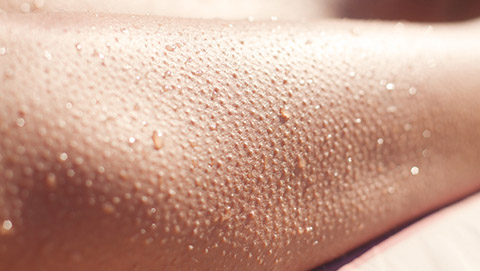
A person reports sporadic episodes of unexplained goosebumps all down one side of the body. No other symptoms are present: no pain, tingling, numbness, or anything.
Is it dysautonomia? Is it a weird kind of seizure?
What are goosebumps good for, anyway?
It turns out they might be more important than we thought.
Resources: 
Pocket Pathology: /abmp-pocket-pathology-app
Ask a Scientist: Why doesn’t your face get goosebumps? (no date). Available at: https://www.pressconnects.com/story/news/local/aroundtown/2016/02/06/ask-scientist-face-get-goosebumps/79935204/ (Accessed: 25 May 2022).
Goosebumps on Skin: When You’re Not Cold and More (2017) Healthline. Available at: https://www.healthline.com/health/goosebumps-on-skin (Accessed: 25 May 2022).
Kurita, T. et al. (2013) ‘Pilomotor seizures in temporal lobe epilepsy: A case report with sequential changes in magnetic resonance imaging’, Epilepsy & Behavior Case Reports, 1, pp. 142–145. doi:10.1016/j.ebcr.2013.08.003.
MD, R.H.S. (2020) Wondering about goosebumps? Of course you are, Harvard Health. Available at: https://www.health.harvard.edu/blog/wondering-about-goosebumps-of-course-you-are-2020080320688 (Accessed: 25 May 2022).
Temporal Lobe Epilepsy (TLE): Causes, Symptoms & Treatment (no date) Cleveland Clinic. Available at: https://my.clevelandclinic.org/health/diseases/17778-temporal-lobe-seizures (Accessed: 25 May 2022).
The hair-raising reason for goosebumps: The same cell types that cause goosebumps are responsible for controlling hair growth (no date) ScienceDaily. Available at: https://www.sciencedaily.com/releases/2020/07/200720112325.htm (Accessed: 25 May 2022).
What goosebumps are for (2020) National Institutes of Health (NIH). Available at: https://www.nih.gov/news-events/nih-research-matters/what-goosebumps-are (Accessed: 25 May 2022).


Books of Discovery:www.booksofdiscovery.com
Anatomy Trains:www.anatomytrains.com
Anatomy Trains is a global leader in online anatomy educationand alsoprovides in-classroom certification programs forstructuralintegration in the US, Canada, Australia,Europe, Japan, and China, as well as fresh-tissue cadaverdissectionlabs and weekend courses. The work of Anatomy Trains originated with founder Tom Myers, who mapped the human body into 13 myofascial meridians in his original book, currently in itsfourthedition and translated into 12 languages. The principles of Anatomy Trains are used by osteopaths, physical therapists, bodyworkers, massage therapists, personal trainers, yoga, Pilates,Gyrotonics, and other body-minded manual therapists and movement professionals. Anatomy Trains inspires these practitioners to work with holisticanatomy in treating system-wide patterns to provide improved client outcomes in terms of structure and function.
Website:anatomytrains.com
Email:info@anatomytrains.com
Facebook:facebook.com/AnatomyTrains
Instagram: www.instagram.com/anatomytrainsofficial
YouTube:https://www.youtube.com/channel/UC2g6TOEFrX4b-CigknssKHA
0:00:01.2 Speaker 1: Hey, I Have a Client Who listeners. Did you know I have a growing library of NCB approved one-hour online self-paced continuing education courses that you can do any time, anywhere? Well, now you know. Current classes include, "What's Next? COVID-19 Updates for Massage Therapists" and "A Massage Therapist's Introduction to Pharmacology Part One", and brand new, "A Massage Therapist's Introduction to Pharmacology Part Two." Classes are $20 each, and they confer one hour of continuing education credit. Wanna know more? Visit my website at ruthwerner.com and check it out. Be sure to sign up for my mailing list so you'll never miss a new class.
0:00:47.6 Speaker 2: Anatomy Trains is delighted to invite you to our in-person fascial dissection workshop, May 30th through June 3rd, 2022. We're excited to be back in the lab with Anatomy Trains, author Tom Myers and master dissector Todd Garcia in Todd's Laboratory of Anatomical Enlightenment in Boulder, Colorado. Join students from around the world and from all types of manual, movement, and fitness professions to explore the real human form, not the images you get from books. Visit anatomytrains.com for details.
[music]
0:01:33.5 Speaker 1: Hi, and welcome to I Have a Client Who, Pathology Conversations with Ruth Werner, the podcast where I will discuss your real life stories about clients with conditions that are perplexing or confusing. I'm Ruth Werner, author of "A Massage Therapist's Guide to Pathology", and I have spent decades studying, writing about, and teaching about where massage therapy intersects with diseases and conditions that might limit our client's health. We almost always have something good to offer even with our most challenged clients, but we need to figure out a way to do that safely, effectively and within our scope of practice, and sometimes as we have all learned, that is harder than it looks.
0:02:20.0 S1: Today's episode is not an I Have a Client Who story per se, it is from a massage therapist who is sharing this about their spouse, they are extra concerned about privacy and confidentiality, so I have removed any identifying information and pronouns, but this was such a fascinating situation and I felt compelled to share it with you, so with their permission, I will. And it goes like this, "Hi, all, I'd just like to reach out and see if anyone has heard of this problem, or has any ideas on treating. My spouse has had spasmodic episodes of goosebumps or chills down their left side starting from the face, down their arm, torso and leg, but only on one side. No other symptoms, no pain, numbness or tingling, purely chills and goosebumps on their skin. It has in the main happened after they've been stressed or angry with something, but not always, it happens mainly on, or around the full moon, but not always, and try telling that to a doctor. It happened in the doctor's office during an appointment, also during a phone consultation with a neurologist. The sensations usually happen around once a month for two or three days, lasting about five minutes or so per episode. The neurologist has arranged for an MRI brain scan to rule out any type of seizure, but has never heard of anything similar.
0:03:46.9 S1: My spouse also has some episodes of vertigo, which did not respond to the Epley maneuver, but has responded to a gentle neck exercise that the physical therapist gave them to do. My spouse has always maintained that their neck was the issue, as when I work gently on it, the problems eased but not permanently. The physical therapist was adamant that they had no neck problems, but my spouse persisted and the PT reluctantly gave them this movement to do and they do it every day, and the vertigo seems to have gone. I'm concerned that the specialist will just prescribe medication for seizures, which my spouse might not need, just because there's nothing else to do for them, so I'm thinking I might try a local Bowen practitioner." Okay, so we have a few things going on here, sporadic goosebumps, maybe a seizure disorder, some kind of vertigo, and I will add that although our contributor links the goosebumps episodes to the full moon, this is not related to a menstrual cycle, and the goosebumps are the salient point, so let's focus on that for the moment. Goosebumps, we all know what we're talking about, right? They have a bunch of different names in the medical community, and you know me, I just can't resist this stuff.
0:05:05.7 S1: Gooseflesh is obvious, when our skin is activated like this, we look like a plucked goose. Cutis anserina is another name, cutis for skin like cuticle, and anserina means goose. You might remember we have an area at the knee where the Sartorius Gracilis and semitendinosus attach at the medial tibia. Pes anserine means goosefoot because that's what those joined up tendons look like. Other names for goosebumps, horripilation, piloerection or the pilomotor reflex. Aha, that last one is a clue. The pilomotor reflex occurs as part of a sympathetic response. This is of course regulated by the hypothalamus with the help of some other brain structures like the amygdala and the pituitary gland, and what elicits this sympathetic response? Typically, it's one of two issues, feeling cold, or feeling strong emotions. If we think back to our way, way, way, long ago ancestors like our pre-human ancestors, we had a lot more body hair then than we do now.
0:06:18.5 S1: Being able to create loft to trap warm air next to the skin was an important survival mechanism, and we see it today when we see warm-blooded animals in cold temperatures, think of those fluffy squirrels raiding your bird feeder in February, or the birds on the bird feeder themselves all puffed out to keep warm. We can't do that with body hair anymore, no matter how hard we try, so we fake it with down jackets, it's exactly the same strategy, but our sympathetic motor nerves and the way they connect to the Arrector pili muscles in each hair shaft, they still try to do their best to create loft, it is an exercise in futility. We also get goosebumps when we feel those strong emotions. Sexual feelings can do this, or being deeply moved by art or music, and we call it getting chills. We've probably seen this or felt it ourselves during massage, I knew a teacher once who called it pleasure bumps, and it can happen when we are fearful, or angry.
0:07:19.8 S1: In animals, we see this when a dog's ruff goes up, or when a cat's tail gets puffed out, the animal makes itself look bigger in the face of a threat. Goosebumps in humans seem to be a sort of a leftover vestigial reflex that we inherited from our pre-human ancestors, but some of those leftover reflexes turn out to serve us well, and I will share some interesting new findings about the benefits of goosebumps before we finish. But what on earth could be going on for the person in today's story, it's hard to say, one person familiar with this case suggested that maybe they were having some kind of mild dysautonomia.
0:08:01.8 S1: Well, dysautonomia is a huge topic having to do with dysfunction in autonomic responses. I did a search for goosebumps and dysautonomia and found, to my surprise, that this link is unlikely. In fact, the opposite is more likely to be the case. People with various forms of dysautonomia have fewer goosebump episodes than others. This is just a different kind of autonomic dysfunction. Another possibility is a specific kind of seizure disorder called temporal lobe epilepsy, and this was brought up by our contributor's neurologist. I looked into this a little, and there are some interesting possibilities for this person.
0:08:42.7 S1: The Cleveland Clinic describes temporal lobe epilepsy this way, "You may have an aura before a temporal lobe seizure. An aura is an unusual sensation that you feel before a seizure starts, not everyone experiences an aura. An aura is part of a focal aware seizure, meaning you're awake and aware while the symptoms occur, and they typically last from a few seconds to two minutes. Sensations you may feel during an aura include: Deja vu, a feeling of familiarity, a memory, or jamais vu, a feeling of unfamiliarity, a sudden sense of fear, panic or anxiety, anger, sadness, or joy, a rising, sick feeling in your stomach.
0:09:29.3 S1: The feeling you get in your gut riding a roller coaster, or an altered sense of hearing, sight, smell, taste or touch." Oh, and one symptom, not on this list but on others, goosebumps. And I wonder if our subject's version of a sudden sense of fear or panic or their roller coaster feeling manifests as vertigo, that is not treatable with the Epley maneuver, which means it's not benign paroxysmal positional vertigo, which is the most common kind of vertigo.
0:10:01.1 S1: I also found a case report about a man who reported frequent episodes of goosebumps on his back with no other signs or symptoms, but the episodes increased in frequency to the point of really interfering with his life. He was always completely conscious and communicative during these episodes, which we don't see with other types of seizures. He was eventually diagnosed with temporal lobe epilepsy, treated with an anti-seizure drug and his symptoms subsided. After he stopped using the drug, he reported feeling occasional chills but not getting goosebumps. So it's not the best possible outcome, but it is within the range of possibility that the subject of our podcast is dealing with a temporal lobe seizure disorder, if it's not seriously interfering with their quality of life then treating it with medication might not be necessary.
0:10:53.3 S1: I think pursuing this with Bowen work might yield some good results, and I might also suggest looking into acupuncture, if they have a trusted provider. Goosebumps in humans are an interesting, but are not especially useful response to being cold or emotionally stressed, but we have recently found out that they may have a hidden purpose, exercising the arrector pili muscles may promote hair growth. Here's a quote from a National Institutes of Health News report on this topic from July of 2020. To test this idea, the researchers compared mice exposed to other cold or normal room temperatures. The cold exposure first caused goosebumps, then boosted activity in the sympathetic nerves and an increase in noraphenafum. Mice exposed to the cold started to produce new hairs from their stem cells in less than two weeks. "It's a two-layer response, goosebumps are a quick way to provide some sort of relief in the short term, but when the cold lasts, this becomes a nice mechanism for the stem cells to know it's time to regenerate new hair, says Dr. Julia Schwartz, a post-doctoral researcher in the Sue lab which who is the first author of the study.
0:12:09.4 S1: Arrector pili muscle cells are often lost in the scalps of people with common baldness, finding a way to reactivate the sympathetic nerves in hair follicles despite this loss, may provide a way to boost hair growth. The team is also interested in studying whether these interactions might play a role in other processes in the skin such as wound healing." And that's the end of the quote from that news report from the National Institutes of Health.
0:12:37.3 S1: So, there you have it, goosebumps, a short foray into one type of epilepsy and a cure for baldness, all in one podcast. Thank you so much, contributor, for giving me this opportunity to learn some new things, and thank you, listeners, for considering some new ideas along with me. Do you have other ideas you want me to think about, let me know. Hey, everybody, thanks for listening to, I have a Client Who, Pathology Conversations with Ruth Werner. Remember, you can send me your I Have a Client Who stories to ihaveaclientwho@abmp.com. That's I have a client who all one word, all lowercase @ abmp dot com. I can't wait to see what you send me, and I'll see you next time.
[music]